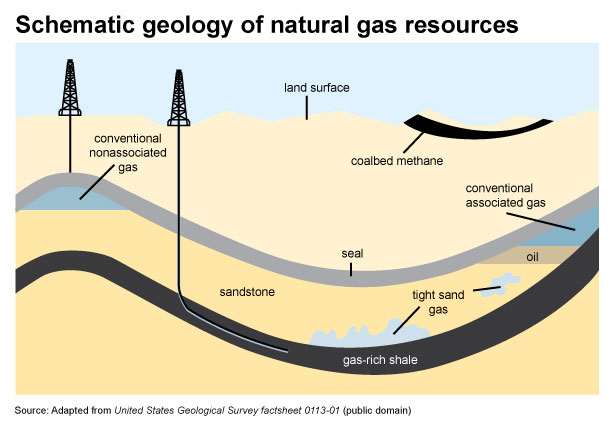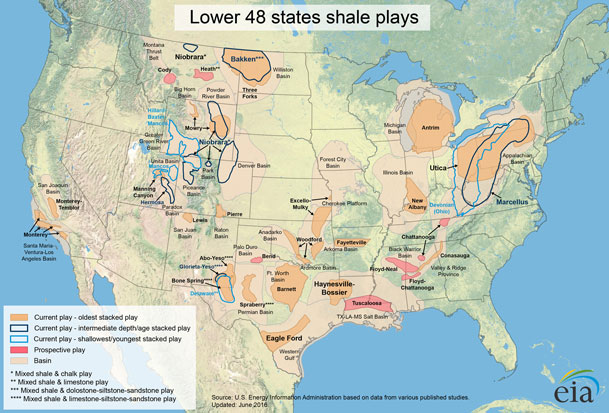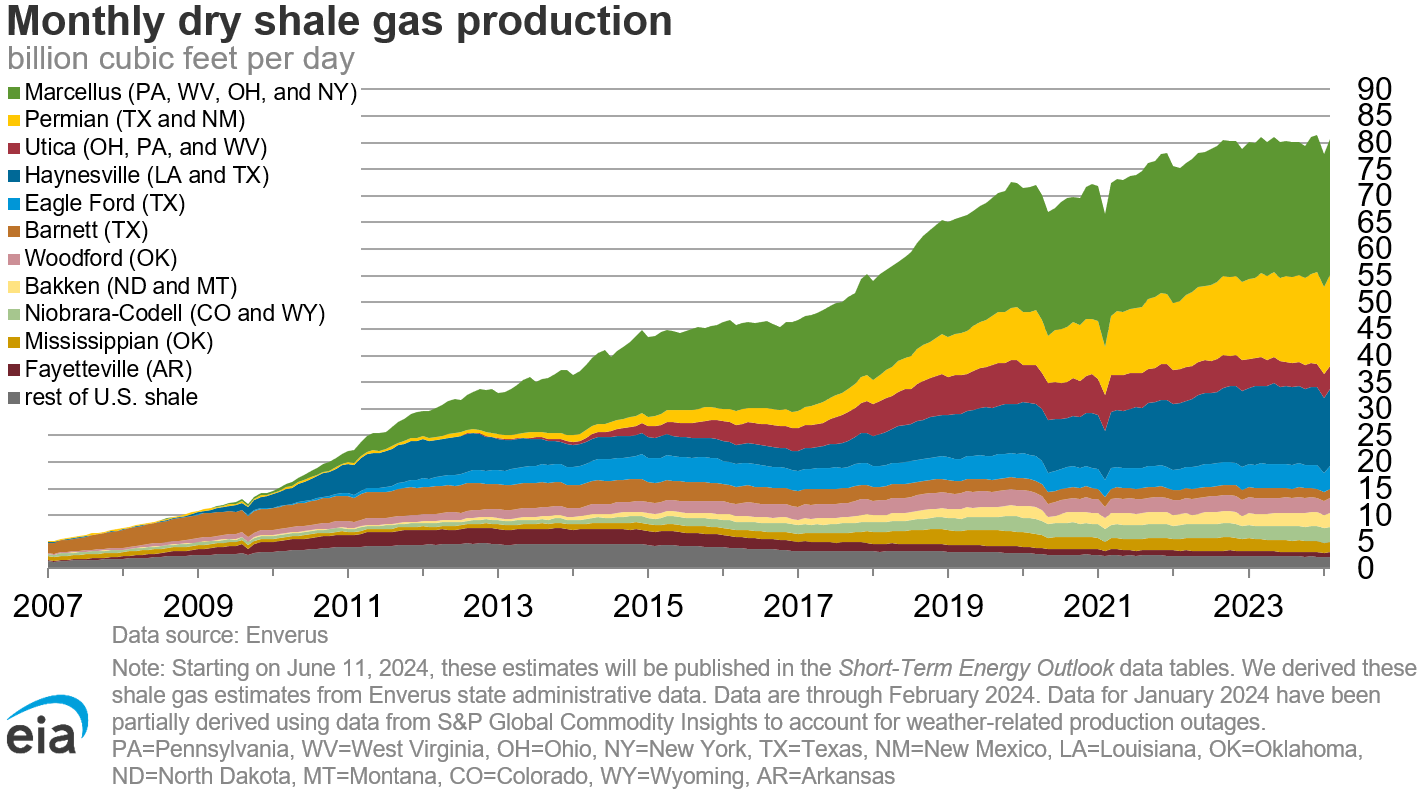The United States now produces nearly all of the natural gas that it uses
In 2022, U.S. dry natural gas production was about 36.35 trillion cubic feet (Tcf), an average of about 96.60 billion cubic feet per day and an annual record high. Most of the production increases since 2005 are the result of horizontal drilling and hydraulic fracturing techniques, notably in shale, sandstone, carbonate, and other tight geologic formations. Natural gas is produced from onshore and offshore natural gas and oil wells and from coalbeds. In 2022, U.S. dry natural gas production was about 13% higher than total U.S. natural gas consumption. Domestic production fullfills most U.S. natural gas consumption, so the United States imports some natural gas to help supply domestic demand.
In 2022, U.S. dry natural gas production was about 1.82 Tcf higher than in 2021, mostly because of higher demand, especially for exports, and higher prices.
Five of the 34 natural gas-producing states accounted for about 70.4% of total U.S. dry natural gas production in 2022.
- The top five natural gas-producing states and their percentage shares of total U.S. natural gas production in 2022 were:
- Texas24.6%
- Pennsylvania21.8%
- Louisiana9.9%
- West Virginia7.4%
- Oklahoma6.7%
Coalbed methane and supplemental gaseous fuels
Coalbed methane obtained from coal seams, or beds, contributes to the U.S. natural gas supply. In 2022, U.S. coalbed methane production was about 2% of total U.S. dry natural gas production.
Supplemental gaseous fuels also contribute to U.S. natural gas supply. They include biogas (sometimes called renewable natural gas), synthetic natural gas, and other gases. The largest single source of synthetic natural gas in the United States is the Great Plains Synfuels Plant in Beulah, North Dakota, where coal is converted to pipeline-quality natural gas. Supplemental gaseous fuel production equaled about 0.2% of U.S. natural gas production in 2022.
Offshore natural gas production
Although most U.S. natural gas and oil wells are on land, some wells are drilled into the ocean floor in waters off the coasts of the United States. In 2022, total offshore dry natural gas production was about 0.80 Tcf. This volume was equal to about 2.3% of total U.S. dry natural gas production. The majority—87.6%—of total U.S. offshore natural gas production was in federal waters in the Gulf of Mexico. Offshore production from ocean waters administered by Alabama, Alaska, California, Louisiana, and Texas was about 0.3% of total U.S. dry natural gas production in 2022.
What is shale?
Shale is a fine-grained sedimentary rock that forms when silt and clay-size mineral particles are compacted, and it is easily broken into thin, parallel layers. Black shale contains organic material that can generate oil and natural gas that is trapped within the rock's pores.
Where are shale gas resources found?
Shale natural gas resources are found in shale formations that contain significant accumulations of natural gas and oil. These resources, or plays, are found in about 30 states. The Barnett Shale in Texas has been producing natural gas for more than a decade. Information gained from developing the Barnett Shale provided the initial technology template for developing other shale plays. The role of the Barnett Shale play has diminished over time as other plays have been developed. Currently, the Marcellus shale play in the Appalachian Basin, spanning Ohio, Pennsylvania, and West Virginia, is the largest source of natural gas from shale.
Shale gas and tight gas
The oil and natural gas industry generally distinguishes between two categories of low-permeability formations—formations with oil and natural gas trapped in microscopic pores in the rock—that produce natural gas:
- Shale natural gas
- Tight natural gas
Shale natural gas
Large-scale natural gas production from shale began around 2000, when shale gas production became a commercial reality in the Barnett Shale located in North Central Texas. Natural gas production in the Barnett Shale was pioneered by the Mitchell Energy and Development Corporation. During the 1980s and 1990s, Mitchell Energy experimented with alternative methods of hydraulically fracturing the Barnett Shale. By 2000, the company had developed a hydraulic fracturing technique that produced commercial volumes of shale gas. As the commercial success of the Barnett Shale became apparent, other companies started drilling wells in this formation, and by 2005, the Barnett Shale was producing almost half a trillion cubic feet (Tcf) of natural gas per year. As natural gas producers gained confidence in their abilities to profitably produce natural gas in the Barnett Shale and saw confirmed results in the Fayetteville Shale in northern Arkansas, producers started developing other shale formations. These new formations included the Haynesville in eastern Texas and north Louisiana, the Woodford in Oklahoma, the Eagle Ford in southern Texas, and the Marcellus and Utica shales in northern Appalachia.
Tight natural gas
Tight natural gas was first identified as a separate category of natural gas production with the passage of the Natural Gas Policy Act of 1978 (NGPA). The NGPA established tight natural gas as a separate wellhead natural gas pricing category that could sell at unregulated market-determined prices. The tight natural gas category gave producers an incentive to produce high-cost natural gas resources when U.S. natural gas resources were believed to be increasingly scarce.
As a result of the NGPA tight natural gas price incentive, these resources have been in production since the early 1980s, primarily from low-permeability sandstones and carbonate formations and from a small production volume of eastern Devonian shale. With the full deregulation of wellhead natural gas prices and the repeal of the associated Federal Energy Regulatory Commission (FERC) regulations, tight natural gas no longer has a specific definition, but it generically still refers to natural gas produced from low-permeability sandstone and carbonate reservoirs.
Notable tight natural gas formations include but are not confined to:
- Clinton, Medina, and Tuscarora formations in Appalachia
- Berea sandstone in Michigan
- Bossier, Cotton Valley, Olmos, Vicksburg, and Wilcox Lobo along the Gulf Coast
- Granite Wash and Atoka formations in the Midcontinent
- Canyon formation in the Permian Basin
- Mesaverde and Niobrara formations in multiple Rocky Mountain basins
EIA projects that shale and tight gas resources are the largest sources of U.S. natural gas production out to 2050
The United States has access to significant natural gas resources. According to projections in the Annual Energy Outlook 2023 (AEO2023), the majority of U.S. dry natural gas production through 2050 will be from shale and tight gas resources.
Page updated December 21, 2023; monthly dry shale gas production chart updated on April 3, 2024.



